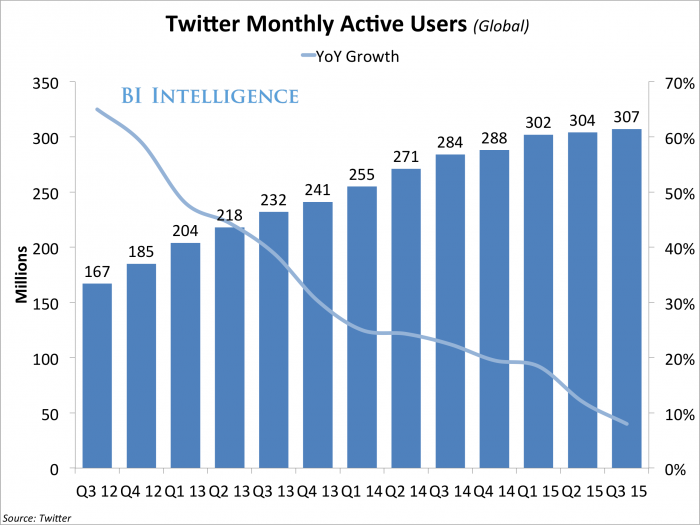 BI Intelligence
BI Intelligence
This story was delivered to BI Intelligence “Digital Media Industry Insider” subscribers. To learn more and subscribe, please click here.
Touchdown Twitter!
The social media company beat out Facebook, Amazon, Verizon, and Yahoo in a bid to secure 10 of the NFL’s Thursday Night Football games in the 2016-17 season, the league announced Tuesday. The deal lets Twitter stream the games worldwide without the need to sign in to or register for the site.
This is an enormous deal for Twitter because it helps secure the platform as the go-to place for live experiences, which progresses the mission of CEO Jack Dorsey.
Twitter could use the NFL streams to bring in new traffic to its platform, especially cord cutters who no longer have cable packages. Even though people don’t have to log in to watch the streams, Twitter could still analyze the number of people watching the streams and then boast that number to marketers.
The platform could also provide a richer viewing experience by letting signed-in users watch the game and discuss it through tweets in real time on the same screen, which could drive up user growth and engagement.
CBS and NBC, both of which own the rights to broadcast Thursday Night Football games, will retain approximately 50 of 70 ad slots during the games, but Twitter will have rights to the rest of the remaining digital inventory, according to Variety. If Twitter can increase site traffic during games, then it could sell more ad inventory at a premium.
Furthermore, Twitter could use the NFL content to highlights its Periscope and Moments services. According to the terms of the deal, players and teams will reportedly broadcast on Periscope before and after the games.
Finally, the NFL deal should help distinguish Twitter from other social media platforms that have sports streaming rights. Yahoo has rights to stream live MLB games, PGA Tour programming, and the first NHL game of the season. Snapchat has weekly content agreements with the major U.S. sports leagues. Facebook has its Sports Stadium feature that lets fans come together and discuss sporting events.
But Twitter’s deal with the NFL should trump all of these thanks to the NFL’s popularity. The league had 43 of the 50 most-watched sporting events in the U.S. in 2015, according to SportsMediaWatch.
This deal should also be interesting to see play out on mobile, where video has surged. Fans can now take out their smartphones and watch an NFL game as opposed to sitting in front of a television or a computer.
And this is just one way that mobile video is changing the game.
Margaret Boland, research analyst for BI Intelligence, Business Insider’s premium research service, has compiled a detailed report on mobile video that takes a look at how short-form mobile video has exploded. The report examines how YouTube, the historically dominant force in short-form video, was slow to implement a mobile video strategy, opening the door for new players —namely Facebook and Snapchat — to emerge.
It also takes a look at how winners will begin to emerge in distinct video content categories. YouTube, for instance, will rely heavily on its homegrown YouTube stars to distinguish its video library and drive loyalty. Facebook will become the go-to place for brands and media companies to engage with the largest audience. And Snapchat will utilize its live-events coverage and exclusive content to promote video communication among younger mobile audiences.
Here are some key takeaways from the report:
- The rise in mobile video viewing can be attributed to several factors: an increase in overall time spent on mobile, the convenience of on-demand viewing, a preference for digital video viewing, and the increased availability of mobile video content.
- As video becomes mobile-first, YouTube’s hold on the short-form video industry is waning. The number of videos that are uploaded to the platform per month has remained stagnant over the past year, according to Socialbakers data shared with BI Intelligence.
- Facebook is in the best position to upset YouTube as the go-to place for brand and media companies to upload videos and for users to watch these videos. Although Snapchat may not be competing with Facebook and YouTube on video volume, the app is changing how consumers, brands, and publishers are using mobile video for communication, news and entertainment, and live-event coverage.
In full, the report:
- Maps out the rise of mobile video viewing and lays out the main drivers of this trend.
- Examines why YouTube’s hold on the short-form video industry is waning as viewers migrate to mobile viewing.
- Illustrates the dramatic increase in the number of videos that brands and media companies are publishing to Facebook over the past year.
- Forecasts the number of videos that US brands and media companies will publish to both Facebook and YouTube in 2016.
- Explains how Snapchat is able to compete with larger video platforms and is changing how brands, media companies, and consumers are using mobile video.
To get your copy of this invaluable guide, choose one of these options:
- Subscribe to an ALL-ACCESS Membership with BI Intelligence and gain immediate access to this report AND over 100 other expertly researched deep-dive reports, subscriptions to all of our daily newsletters, and much more. >> START A MEMBERSHIP
- Purchase the report and download it immediately from our research store. >> BUY THE REPORT
The choice is yours. But however you decide to acquire this report, you’ve given yourself a powerful advantage in your understanding of the rapidly changing world of mobile video.














